![]()
Aroids and other genera in the Collection
Take the Tour Now?
Orchids
The
Exotic Rainforest
Plants in
the Exotic Rainforest Collection
Images on this website are copyright protected. Contact us before
attempting to reuse.
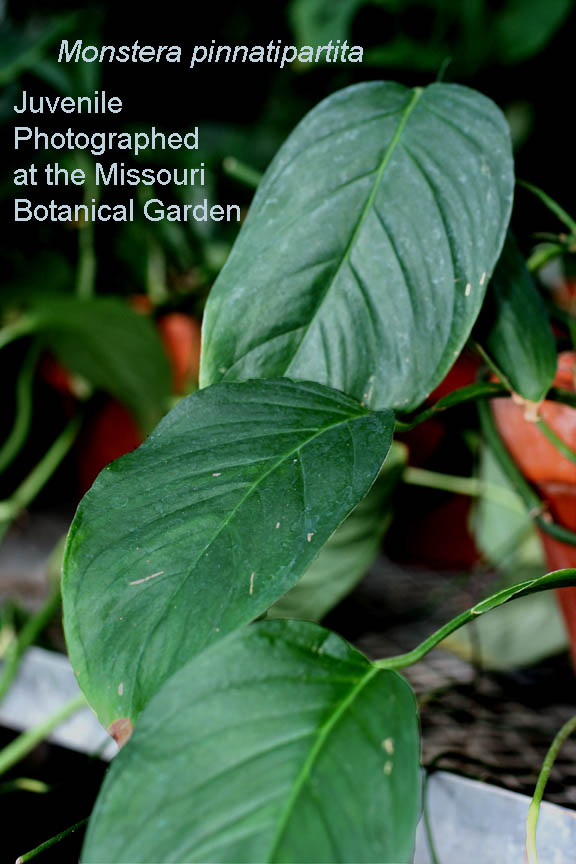
Aroids in the genus Monstera are Neotropical species. The Neotropics or Neotropical zone is one of eight terrestrial ecozones found on our planet that includes South and Central America, southern Mexico, the Caribbean islands, and southern Florida. Despite the common belief Monstera species are found in Asia they are not native to any Asian country. There are however related genera in that part of the world since Monstera, Rhaphidophora, Epipremnum, Amydrium and Scindapsus are all are found in the aroid tribe Monsterea.
Many plants are incorrectly sold using this scientific name. The photo above was photographed in the research greenhouse of the Missouri Botanical Garden in St. Louis in an effort to determine which plant is truly the species Monstera pinnatipartita in the juvenile form. As you read, see if you can determine how Monstera pinnatipartita received its scientific name.
Monstera
pinnatipartita
is found in nature in Colombia, the northwestern portion of Ecuador and
into Peru. Collections
have also been reported in the Central American
country of Costa Rica. This Monstera species grows as an
appressed- climbing vine as either a hemiepiphyte or epiphytic. The term
appressed
refers to plant
parts such as the stem of some Philodendron and other genera that grow pressed
closely against the surface of a host for much of its length.
climbing vine as either a hemiepiphyte or epiphytic. The term
appressed
refers to plant
parts such as the stem of some Philodendron and other genera that grow pressed
closely against the surface of a host for much of its length.
A stem is
the base, central axis and main support of a plant that is normally
divided into nodes and internodes. The nodes often produce a leaf
supported on a petiole while the stem's roots anchor the plant either to
the ground or the host tree. A stem is not the stalk that supports any
single leaf, the support stalk is the petiole.
Epiphytes
are plants that do not have roots in the soil. Epiphytes live
above the ground's surface supported by another plant, normally a tree.
Epiphytes gather their nutrients and water from the air or from organic
debris from the host in the form of decaying vegetation or the droppings
of rain forest animals.
Hemiepiphyte are
divided into two types. The primary hemiepiphytes begin as seeds in the
droppings of a rain forest inhabitant which germinate on the trunk or
limbs of a tree as do an epiphyte then develop long roots which
eventually reach the ground. They then attain height in the forest as
quickly as possible in order to reach brighter light. Secondary
hemiepiphytes start their lives in the soil or on a tree trunk near the
ground with roots to the ground to gather additional nutrients. They
then climb the host where they morph into the adult form and sometimes
completely lose their connection to the ground.
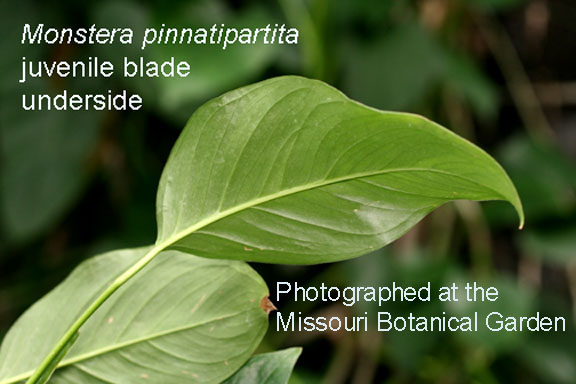 Although
the genus Monstera and the genus Philodendron are related, the
plants in those genera are not one and the same. There are several differences in Monstera
that include the growth of holes known to science as fenestrations and
the presence of a geniculum which is commonly associated with plants in
the genus Anthurium that allows the leaf to rotate to some
degree to orient itself to better gather light. Monstera also have
differences in their sexual reproductive process. By the way,
those
"holes" or windows eventually turn into pinnate lobes.
Although
the genus Monstera and the genus Philodendron are related, the
plants in those genera are not one and the same. There are several differences in Monstera
that include the growth of holes known to science as fenestrations and
the presence of a geniculum which is commonly associated with plants in
the genus Anthurium that allows the leaf to rotate to some
degree to orient itself to better gather light. Monstera also have
differences in their sexual reproductive process. By the way,
those
"holes" or windows eventually turn into pinnate lobes.
The inflorescence of Monstera species also produce perfect unisexual flowers which include both sexes within a single flower while Philodendron species produce bisexual flowers that have both male and female flowers which grow individually.
Monstera pinnatipartita
was
originally described to science in 1857 and as a result has been around
collections for a long time.
When
this Monstera species first appeared on eBay we were forced to go
through quite a process of elimination before finally receiving
confirmation from Dr. Tom Croat of the Missouri Botanical Garden to
confirm the name. Numerous email exchanges with other collectors made it
apparent some considered this plant to be Monstera dobsonii, Monstera
karstenianum or Monstera siltepecana,. There are
similarities to the juvenile form of Monstera dubia but upon
close examination the differences are apparent. This ornate juvenile
form with silver markings is from the western portion
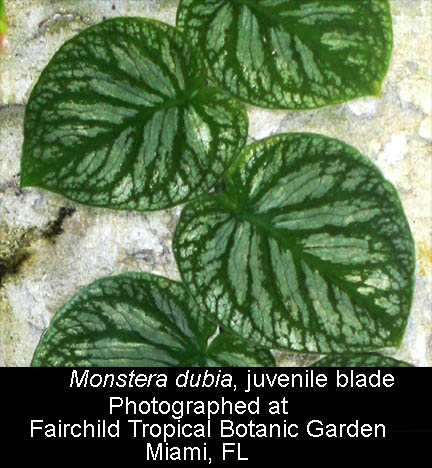 of South America
south to Peru and looks nothing like its adult form.
of South America
south to Peru and looks nothing like its adult form.
Specimens are normally found in wet to moist rain forests and as
it matures the leaf develops holes in the leaves which are known as
windows or fenestrations before the leaves become strongly pinnatifid.
A pinnatifid leaf is one with deep "incisions" in the leaf sometimes
almost reaching the midrib. See Dr. Croat’s photo in this article of a
semi-adult as well as fully adult leaf.
More photographs of the adult leaf blades of Monstera pinnatipartita
can be seen on the website of aroid botanist David Scherberich here:
Monstera.html
The lamina of the leaf blades of Monstera pinnatipartita are coriaceous or thinly coriaceous as well as moderately glossy to semi-glossy on both leaf surfaces. The leaf blades ovate to elliptical and the blade may be bicolorous (two colored) in juvenile plants but the bi-coloration is lost as the plant matures. Adult leaf blades are dark green on the adaxial (upper) surface while medium green below on the abaxial surface. There may be from 3 to 9 lobes on each side of the pinnate blade.
A pinnate leaf possesses lobes or branches on each side of the midrib. In aroid species the leaf lamina may be deeply cut to the midrib in order to appear to be somewhat feather-like in appearance.
The major veins of the leaf blades are slightly round raised and are quilted (appearing to have been “quilted” or padded with a “rolling” lamina) as well as sunken above with the midrib narrowly ridged as well as paler in color on the upper surface. The primary lateral veins are concolorous (single colored), convex and whitish on the lower blade surface. The midrib is also sunken as well as concolorous on the adaxial surface while being narrowly rounded and paler in color below. The minor veins are noticeably fine and sometimes hardly visible.
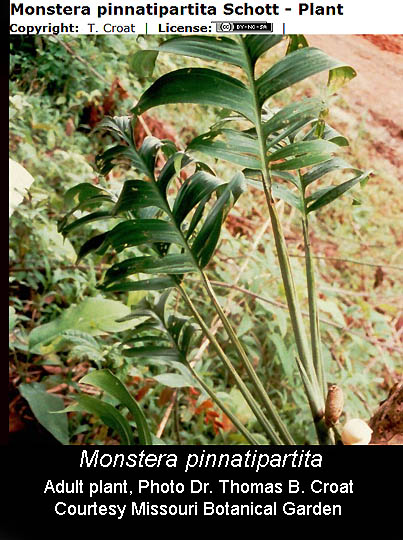 The
primary lateral leaf vein are the veins on a leaf blade which assist to
mechanically support a leaf blade while branching off the midrib and
extending to the leaf margins (edges). The interprimary leaf veins are
slightly lesser prominent and are found between the primary leaf veins
but larger than the smaller tertiary veins.
The
primary lateral leaf vein are the veins on a leaf blade which assist to
mechanically support a leaf blade while branching off the midrib and
extending to the leaf margins (edges). The interprimary leaf veins are
slightly lesser prominent and are found between the primary leaf veins
but larger than the smaller tertiary veins.
The petioles are the stalks that support the blades and are speckled as well as medium to dark green with a matte sheen. The petioles are paler on the adaxial (upper) edge near the apex (top). The petiolar sheath that remains on the stalk is involute and curled inward and is finely striate along margins (edges). The petiole sheaths are extensions on each side of the petiole that appear similar to wings that may envelope the successive newly developing leaf blade. The petiole is smooth as well as possesses either pale speckles or it may be densely flecked with a whitish color. The petioles are also sharply sulcate. When a plant part is referred to as being sulcate the term refers to a series of fine furrows or grooves which are often observed on the upper surface of a petiole, midrib or other plant part.
A sulcate geniculum can be observed at the top (apex) of the petiole and possesses a C-shape. The geniculum is sharply concave on the upper surface. A geniculum is a wrist-like organ always located at the apex of the petiole that allows a leaf to rotate and orient itself in order to control to some degree the sunlight it collects.
Aall Monstera species are aroids and reproduce via the production an inflorescence. The stalk that supports the entire inflorescence is known as the peduncle. When a Monstera species is "in flower" the reference is to the tiny flowers containing both male and female sexual parts that grow on the spadix at the center of the inflorescence. Unlike plants in the genus Philodendron that contain imperfect flowers having only a single sex Monstera possess perfect flowers containing both sexes. To prevent self-pollination nature has designed the female portion of the flowers to be receptive before the male portion produces pollen. In most cases an insect must bring pollen from another plant.
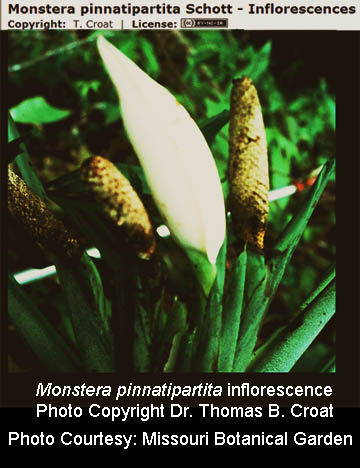 The
inflorescence of an aroid is composed of a spathe and spadix.
Most people believe the spathe is a "flower" which is incorrect. The
spathe is a modified leaf whose purpose is to offer protection to the
spadix at the center of the inflorescence. During sexual anthesis there
can be found very tiny flowers on the spadix when it is ready to produce
seeds. When ready to produce seeds the female portion of the flowers
must first be pollinated as they reach their own sexual anthesis. The
male flower portion produces
pollen after the female flowers are receptive and
If the female flowers are pollinated by an appropriate
Cyclocephala
beetle which carries pollen from another
Monstera
specimen already at male anthesis those female flowers will be
pollinated and the spadix will begin to grow berries containing 1 to 2
seeds.
The
inflorescence of an aroid is composed of a spathe and spadix.
Most people believe the spathe is a "flower" which is incorrect. The
spathe is a modified leaf whose purpose is to offer protection to the
spadix at the center of the inflorescence. During sexual anthesis there
can be found very tiny flowers on the spadix when it is ready to produce
seeds. When ready to produce seeds the female portion of the flowers
must first be pollinated as they reach their own sexual anthesis. The
male flower portion produces
pollen after the female flowers are receptive and
If the female flowers are pollinated by an appropriate
Cyclocephala
beetle which carries pollen from another
Monstera
specimen already at male anthesis those female flowers will be
pollinated and the spadix will begin to grow berries containing 1 to 2
seeds.
Monstera pinnatipartita produces one to two inflorescences per axil with a spathe that is white to whitish cream surrounding a spadix that is green to cream colored to greenish in color. The peduncle that supports the inflorescence is terete (round) as well as slightly speckled, Once pollinated and berries are produced the inflorescence becomes a greenish-white infructescence. The infructescence stands erect with fruits (berries) that are white to pale green at apex (top). This species has been observed to produce an infructescence only 2.5 m above the ground.
Monstera species climb in order to reach brighter light. Wise growers will duplicate this environment as best possible and grow their specimens in bright indirect light in order to make a specimen prosper. A specimen should be potted in fast draining soil that is kept moist but not wet. For more information on mixing proper potting soils see the heading about soil in this link: Growing Anthurium
As can be seen in several of the photos on this page this species morphs as it grows. There continues to be a debate among plant collectors over which species is truly Monstera pinnatipartita since many sellers offer this plant as Monstera siltepecana. The photo to the right at the top of this page was taken by America's top aroid botanist Dr. Tom Croat and as can be seen in the background the juvenile plants match the photos on this page.
Aroids undergo a number of metamorphic changes as they grow including normal changes in growth (ontogeny) as well as natural variation. Aroid species are known to be highly variable and not every leaf of every specimen will always appear the same especially when observed in the juvenile stages. This link explains natural variation and morphogenesis within aroids and other plants. Natural variation
Have you discovered how the plant received its scientific name? Here is a hint. The second part of the name pinnatipartita is derived from the Latin word partitus which means divided into parts.
My thanks to Dr. Tom Croat for the use of his photographs and to Emily Colleti for her assistance when the photos were taken in the Missouri Botanical Garden greenhouse.
Additional photos of this species by Dr. Croat can be seen in the International Aroid Society Newsletter Volume 31, No. 2, June 2009, in his article Trip to the Vth Colombian Botanical Conference, figure 33 and 34, 35, 36
Want to learn more
about aroids?
Join the
International Aroid Society:
Join the IAS